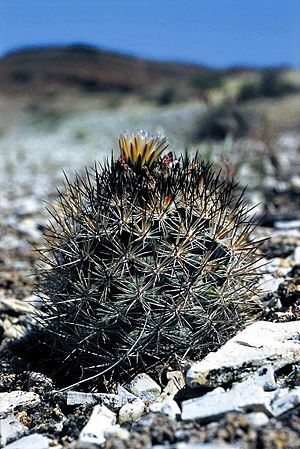Siler's pincushion cactus facts for kids
Quick facts for kids Siler's pincushion cactus |
|
|---|---|
 |
|
| Conservation status | |
| Scientific classification | |
| Kingdom: | |
| (unranked): | |
| (unranked): | |
| (unranked): | |
| Order: | |
| Family: | |
| Genus: | |
| Species: |
P. sileri
|
| Binomial name | |
| Pediocactus sileri (Engelm. ex J.M.Coult.) L.D.Benson
|
|
| Synonyms | |
|
|
Pediocactus sileri is a very rare type of cactus. People often call it the Siler's pincushion cactus or the gypsum cactus. It grows naturally in the southwestern part of Utah and the northwestern part of Arizona in the United States.
This cactus needs a special kind of soil to grow. Individual plants are often found far apart from each other. The species is in danger because of human activities. These include using off-road vehicles, illegally taking plants (called poaching), and uranium mining. The United States government lists this cactus as a threatened species. This means it is protected by law.
Contents
What Does Siler's Pincushion Cactus Look Like?
This cactus usually looks like an egg. Sometimes, it can be shaped more like a cylinder. It might also have short branches. It can grow up to 25 centimeters (about 10 inches) tall. It can be about 11 centimeters (about 4 inches) wide.
Its surface has bumps. These bumps are called areoles. They are covered in soft hairs or woolly fibers. Each areole has 3 to 7 main spines. These spines can be black, gray, or white. The spines near the bottom of the cactus can be up to 3 centimeters long. Each areole also has many smaller white spines. These are usually 1 or 2 centimeters long. The spines around the base of the cactus help it stay in the soil.
Flowers and Fruit
The Siler's pincushion cactus blooms in April and May. Its flowers are about 2 centimeters long and 3 centimeters wide. The outer parts of the flower are brown with white edges. The inner parts are yellow with purple lines. After flowering, the cactus grows a fruit. The fruit is yellow-green and just over a centimeter long.
How Scientists Name This Cactus
The names Pediocactus sileri and Sclerocactus sileri can be a bit confusing. Long ago, the group of plants called Pediocactus included plants now in Sclerocactus. But now, scientists think they are not closely related.
According to a big plant guide called the Flora of North America, the cactus we are talking about was first named Echinocactus sileri in 1896. Later, in 1961, a scientist named L.D. Benson moved it to the name Pediocactus sileri.
Separately, in 1969, L.D. Benson also named a different plant as a type of Sclerocactus pubispinus. This plant was later made into its own species called Sclerocactus sileri in 1994.
So, the Flora of North America lists them as two different species:
- Pediocactus sileri – This is the Gypsum cactus or Siler's pincushion cactus.
- Sclerocactus sileri – This is the Siler fishhook cactus.
It's important to know they are different plants, even if their names sound similar!
Where This Cactus Lives and How We Protect It
This cactus grows in sandy and clay soils. These soils are part of a rock layer called the Moenkopi Formation. The soils have a lot of gypsum and salts. The areas where it grows include desert scrub lands, woodlands, and grasslands. Much of this land is managed by the Bureau of Land Management.
The cactus is found in parts of Coconino and Mohave Counties in Arizona. It also lives in Washington and Kane Counties in Utah. We don't know the exact total number of these cacti. But over 10,000 individual plants have been found. They are spread out over an area of about 34,000 acres (about 138 square kilometers).
Threats to the Cactus
One big threat to this cactus is uranium exploration. When the price of uranium goes up, more people look for it. All the places where this cactus grows could have uranium. Plans for uranium mining are often changed to avoid hurting the cactus. But the danger is still there.
Looking for oil and gas, and mining for gypsum, could also be threats in the future. Off-road vehicles are popular in these areas. There are special roads for them, and some areas are closed to vehicles to protect the plants. Farm animals eating the plants is a small threat. Natural dangers include dry weather (drought) and animals like rodents and rabbits eating the cactus.
Conservation Efforts
To help protect this cactus, the White Dome Nature Preserve was created in Utah. This preserve protects land where the cactus lives. It also protects other rare plants like the dwarf bear claw poppy. Animals like the zebra-tailed lizard and the loggerhead shrike also live there.
See also
 In Spanish: Pediocactus sileri para niños
In Spanish: Pediocactus sileri para niños


